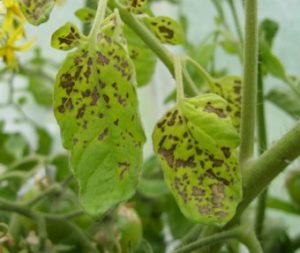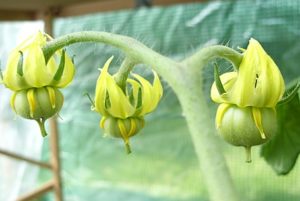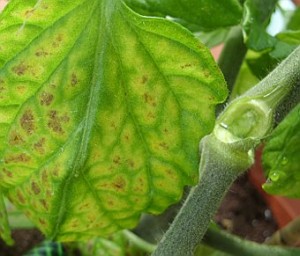The season so far – from my garden!
This year, March was sunny and warm, and one of the warmest March’s on record in the UK. It was very exciting to see the seedlings do so well and grow so quickly with all the fine weather we had. I thought that we were in for one of the best seasons ever!
However, April was one of the wettest months on record and along with the damp and dull weather that we’ve had, the season so far has been disappointing.
Leaf Spot
I’ve just noticed early blight on one of my plants, but the main problem this season for me, and a lot of other tomato growers, has been leaf spot.
It’s caused by damp and dull conditions and is either a bacterial or a fungal problem.

There are about six different leaf spot diseases that look similar, they are:
- Septoria leaf spot
- Grey mould begins with similar symptoms
- Stemphylium leaf spot
- Alternaria leaf spot
- Bacterial spot
- Bacterial speck
Most of these are fungal diseases but bacterial leaf spot/speck can also be a problem in damp dull weather and spring from nowhere!
Prevention
In recent seasons I have tried to be “bio friendly” whenever possible and resisted spraying my plants with a protective fungicide. However, if the weather continues to be as wet as it has been, spraying plants may be the only way to get a good crop.
The traditional method of protection has been Dithane and Bordeaux Mixture, but there are now biofungicides available that would seem to be a good choice for the organic grower.
These work by using friendly fungi to grow a protective barrier around leaves and roots that out-compete and kill the harmful fungi.
Early Setting Varieties
Tomato varieties are often classified by “days from transplanting” and early season, mid-season and late season.
These terms describe the time it takes (in theory) from planting in final position, when a plant begins to flower, to harvesting ripe tomatoes.
I’ve found the “days from transplanting” to be the least helpful because of the time it takes between flowering and fruit setting – when the flowers begin to produce fruit.
If conditions are unfavourable, a delay in pollination can cause a “60 days from transplanting” variety to become a “100 days from transplanting” – the quickness of a variety to set fruit is very important.
For example, I have two bush varieties sat side by side, receiving the same treatment and amount of sun etc.
One is Oregon Spring and the other is Legend. Oregon Spring is 60 days and Legend is 70 days from transplanting.
Oregon Spring started fruiting about a month ago (below) and Legend is yet to begin fruiting.

The variety that is the earliest to mature is usually the variety that is earliest to set fruit.
Red Alert, a bush cherry variety and Oregon Spring, a large fruited bush variety are both early to set fruit and will do so in difficult circumstances – unlike Legend which requires better growing conditions to set fruit.
Broken Branches
One problem with bush varieties is that the weight of fruit will often break a branch or tear it away from the main stem. The fruit will still grow (surprisingly!) if you leave it attached and give the leaves a foliar spray/feed from time to time.

The photo above shows a split branch and a leaf that has seen better days. This is not leaf spot though, it is nutrient deficiency which is very common on lower leaves.
Let’s hope we get some better weather soon!


Avril
I am growing a variety this year, not what I’m used to: Red Alert, Tumbling Tom, Black Cherry, Sun Baby, Polen, Sweet Million, Golden Sunrise, Sungold, Money Maker and Roma. I must say out of all of these I only have 3 pea sized toms. The plants with the most flowers are Red Alert and Tumbling Tom, the TT has 2 of the 3 pea sized toms.
I live in central Scotland and the weather has been pretty cool for this time of year. I am starting to hope I have a good amount of ripe toms before the end of the season!
Lets hope for an Indian Summer!
Nick
Hi Avril,
You’ve got a good selection there!
At this time of the season it seems like the toms will never appear, but in about four or five weeks time your plants will be covered in tomatoes – hopefully!
Regards,
Nick
Rhys Jaggar
Jess
My experience in the SE with Tumblers is the same as yours – now 60 fruit set, one almost ready to be eaten and about another 100 flowers already. They seem a very easy plant to grow.
Alicante and Shirley seem to create new trusses best when temperature is 20C or more. Fruit set seems to be OK at 18C or more. Fruit which are set respond visibly overnight to Tomorite – they swell noticeably overnight.
Marmande seem similar although I’ve not yet tried the Tomorite on the plant as it’s much smaller.
jess allaway
Hi Nick,
I had my first four ripened toms two days ago. These were from one of my tumbler plants. I had been hoping that the Glacier and Latah plants would be the earliest (according to the packet info both of these are amongst “the earliest toms available”). Since none of my Red Alert germinated – from fresh seeds bought this year – these other two are similar semi-bush type to RA. Glacier have huge potato leaves and Latah very sparce ordinary leaves. The Glaciers have each a bunch of 4-5 1.1/2″ toms at the first truss level which seem to have been there forever. I can only assume that the Tumblers did better because they are smaller. I have four of those absolutely laden with fruit and flowers and am expecting to start picking in earnest in about 10 days or so. Has anyone else in the Tomato Club grown Glacier or Latah? Would be interested to know how they did. Our weather in the far north west has been the opposite to that in the south. We had our extreme wet when you had dry and for the last month or so it has been sunny and dry. We a are having a badly needed deluge today which give us a break from watering, watering, but I am just hoping it will remember to go off reasonably soon.
P.S. Am just off to the greenhouse to take your advice on the four stretched left over “orphans”. I had been wondering what to do with those and like yourself hadn’t the heart to put them in the compost.
Nick
Hi Jess,
I grew Latah last season with mixed results – Tumbler and Red Alert are earlier in my garden.
Glacier is similar to Gardener’s Delight but the tomatoes don’t have the fine taste of GD. It was early when I grew it three seasons ago, but still not as early as Red Alert.
I used to grow Tumbler F1 every season but have relied on Red Alert in recent years for my earliest toms. I think next season I’ll compare the two varieties and grow them both – if I remember correctly, there is little difference between them.
Regards,
Nick
Steve
Further to my above comments, greenhouse hygene is paramount. Even a set flower falling and settling on a leaf is a starting site for the fungus. We need some warm weather to get the plants properly ventilated!
Nick
Hi Steve,
Absolutely … some warm weather would be very welcome and make all the difference!
Regards,
Nick
Steve
Hi Nick
This year, for the 1st time in many years, I have seen grey mould (Botrytus sp!) in one of my greenhouses. This is caused by still, cool moist air hanging around the plants. The cure, as far as I’m concerned, is to go in hard with the Stanley knife! I advise anyone who sees this to do the same.